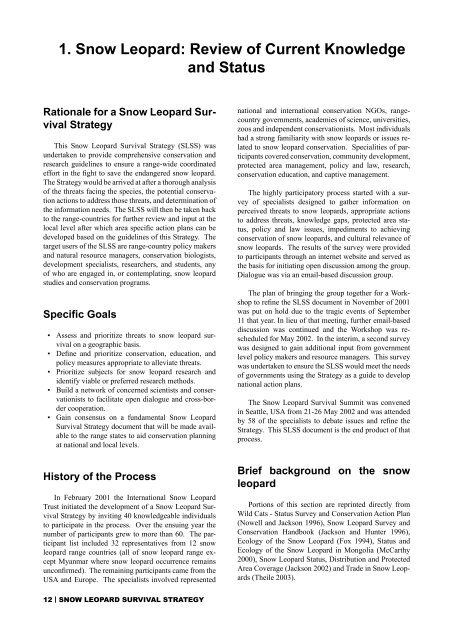Snow Leopard Survival Strategy - Panthera
Snow Leopard Survival Strategy - Panthera
Snow Leopard Survival Strategy - Panthera
You also want an ePaper? Increase the reach of your titles
YUMPU automatically turns print PDFs into web optimized ePapers that Google loves.
1. <strong>Snow</strong> <strong>Leopard</strong>: Review of Current Knowledge<br />
and Status<br />
Rationale for a <strong>Snow</strong> <strong>Leopard</strong> <strong>Survival</strong><br />
<strong>Strategy</strong><br />
This <strong>Snow</strong> <strong>Leopard</strong> <strong>Survival</strong> <strong>Strategy</strong> (SLSS) was<br />
undertaken to provide comprehensive conservation and<br />
research guidelines to ensure a range-wide coordinated<br />
effort in the fight to save the endangered snow leopard.<br />
The <strong>Strategy</strong> would be arrived at after a thorough analysis<br />
of the threats facing the species, the potential conservation<br />
actions to address those threats, and determination of<br />
the information needs. The SLSS will then be taken back<br />
to the range-countries for further review and input at the<br />
local level after which area specific action plans can be<br />
developed based on the guidelines of this <strong>Strategy</strong>. The<br />
target users of the SLSS are range-country policy makers<br />
and natural resource managers, conservation biologists,<br />
development specialists, researchers, and students, any<br />
of who are engaged in, or contemplating, snow leopard<br />
studies and conservation programs.<br />
Specific Goals<br />
• Assess and prioritize threats to snow leopard survival<br />
on a geographic basis.<br />
• Define and prioritize conservation, education, and<br />
policy measures appropriate to alleviate threats.<br />
• Prioritize subjects for snow leopard research and<br />
identify viable or preferred research methods.<br />
• Build a network of concerned scientists and conservationists<br />
to facilitate open dialogue and cross-border<br />
cooperation.<br />
• Gain consensus on a fundamental <strong>Snow</strong> <strong>Leopard</strong><br />
<strong>Survival</strong> <strong>Strategy</strong> document that will be made available<br />
to the range states to aid conservation planning<br />
at national and local levels.<br />
History of the Process<br />
In February 2001 the International <strong>Snow</strong> <strong>Leopard</strong><br />
Trust initiated the development of a <strong>Snow</strong> <strong>Leopard</strong> <strong>Survival</strong><br />
<strong>Strategy</strong> by inviting 40 knowledgeable individuals<br />
to participate in the process. Over the ensuing year the<br />
number of participants grew to more than 60. The participant<br />
list included 32 representatives from 12 snow<br />
leopard range countries (all of snow leopard range except<br />
Myanmar where snow leopard occurrence remains<br />
unconfirmed). The remaining participants came from the<br />
USA and Europe. The specialists involved represented<br />
national and international conservation NGOs, rangecountry<br />
governments, academies of science, universities,<br />
zoos and independent conservationists. Most individuals<br />
had a strong familiarity with snow leopards or issues related<br />
to snow leopard conservation. Specialities of participants<br />
covered conservation, community development,<br />
protected area management, policy and law, research,<br />
conservation education, and captive management.<br />
The highly participatory process started with a survey<br />
of specialists designed to gather information on<br />
perceived threats to snow leopards, appropriate actions<br />
to address threats, knowledge gaps, protected area status,<br />
policy and law issues, impediments to achieving<br />
conservation of snow leopards, and cultural relevance of<br />
snow leopards. The results of the survey were provided<br />
to participants through an internet website and served as<br />
the basis for initiating open discussion among the group.<br />
Dialogue was via an email-based discussion group.<br />
The plan of bringing the group together for a Workshop<br />
to refine the SLSS document in November of 2001<br />
was put on hold due to the tragic events of September<br />
11 that year. In lieu of that meeting, further email-based<br />
discussion was continued and the Workshop was rescheduled<br />
for May 2002. In the interim, a second survey<br />
was designed to gain additional input from government<br />
level policy makers and resource managers. This survey<br />
was undertaken to ensure the SLSS would meet the needs<br />
of governments using the <strong>Strategy</strong> as a guide to develop<br />
national action plans.<br />
The <strong>Snow</strong> <strong>Leopard</strong> <strong>Survival</strong> Summit was convened<br />
in Seattle, USA from 21-26 May 2002 and was attended<br />
by 58 of the specialists to debate issues and refine the<br />
<strong>Strategy</strong>. This SLSS document is the end product of that<br />
process.<br />
Brief background on the snow<br />
leopard<br />
Portions of this section are reprinted directly from<br />
Wild Cats - Status Survey and Conservation Action Plan<br />
(Nowell and Jackson 1996), <strong>Snow</strong> <strong>Leopard</strong> Survey and<br />
Conservation Handbook (Jackson and Hunter 1996),<br />
Ecology of the <strong>Snow</strong> <strong>Leopard</strong> (Fox 1994), Status and<br />
Ecology of the <strong>Snow</strong> <strong>Leopard</strong> in Mongolia (McCarthy<br />
2000), <strong>Snow</strong> <strong>Leopard</strong> Status, Distribution and Protected<br />
Area Coverage (Jackson 2002) and Trade in <strong>Snow</strong> <strong>Leopard</strong>s<br />
(Theile 2003).<br />
12 | SNOW LEOPARD SURVIVAL STRATEGY
















